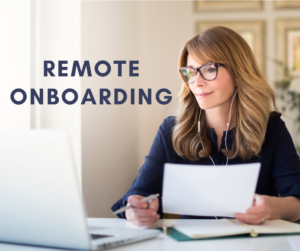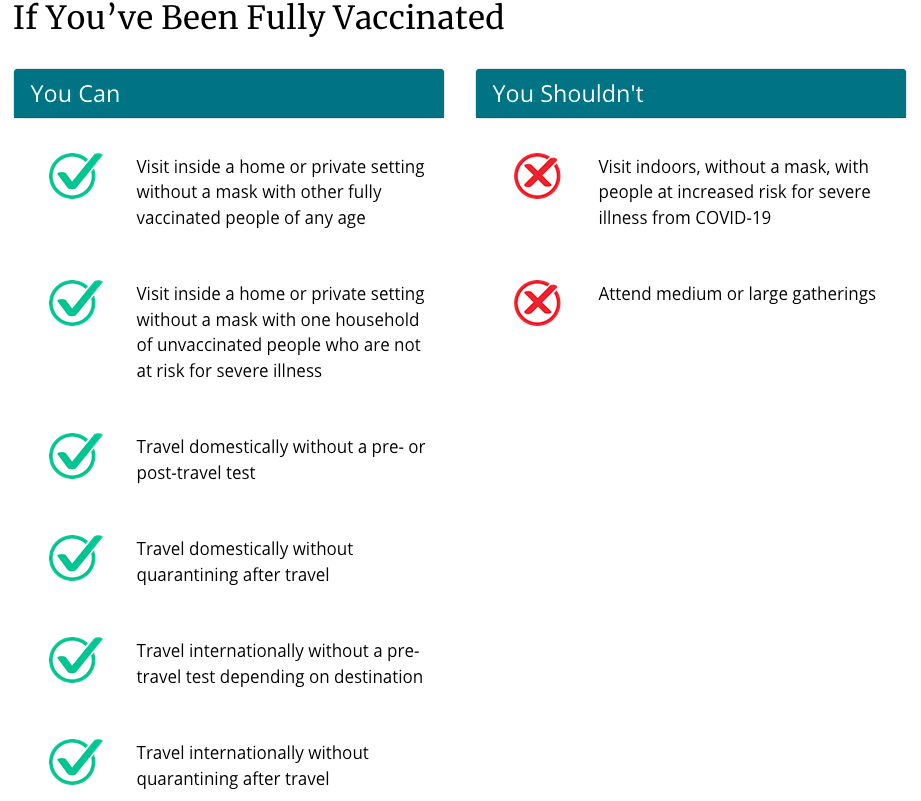
by admin | Apr 27, 2021 | Human Resources
 Remote Onboarding Success Plan
Remote Onboarding Success Plan
Remote workplaces have become very commonplace in our world today. In fact, a PwC survey of 669 CEOs, 78% agree that remote work is here for the long-term. As a result, remote onboarding has become part of the normal Human Resources operation in companies. Let’s dive into what remote onboarding looks like and some benefits and challenges of this new way of welcoming employees to the team.
What is onboarding?
Onboarding is the process of welcoming new employees to the company and introducing them to the company culture of their new employer. Onboarding is different from training in that training focuses on the policies and procedures of the job while onboarding is more focused on integrating the new hire to the team and helping them develop relationships within the workplace. Remote onboarding has the same focus but everything is done online through Zoom or other virtual meeting platforms. Onboarding is also not a one-time event. It’s a process that takes multiple days and an ongoing commitment to truly acclimate the new employee to the department.
Challenges of remote onboarding
Connecting virtually with others can have its challenges. Coordinating the entire team’s schedule to welcome new hires as they arrive on the team can be hard. This same challenge happens as the team attempts to continue to build camaraderie with some in-person team members and other remote team members. As many of us have come to understand, working remotely can be very isolating. Throw in joining a new team, and your new hire can feel extremely unengaged. Another challenge is technology set up in a remote environment. When onboarding in person, the IT department can physically be there to issue company technology. Remote onboarding relies on the new employee setting up their own technology or walking through set-up with an IT representative online.
Tips for remote onboarding success
Despite the challenges, remote onboarding can be a successful experience. Here are some tips to overcome some of these obstacles and make your new hire feel engaged and part of the team by the end of their remote onboarding process.
- Set up a kick-off video call with your entire team to welcome the new member. By having a video call, you make it easier for names and faces to connect. Video welcome calls also allow the new hire to see the enthusiasm in the faces of their new team and begin to build an emotional connection.
- Provide an organizational chart so that the remote employee understands the reporting lines in the company. Additionally, consider including pictures of those included on the chart so they can put faces to names. Another great way to go to the next level to connect with the new hire would be to pre-record quick welcome videos by the high-level execs and send them via email.
- Introduce the new employee to the company via email or social media. Do a simple “Getting to Know You” interview with them so you can share some interesting facts about this new team member.
- Regularly check-in via quick chat messages or video call with your remote new hire to find out if they have any questions or concerns in their first week(s). By having scheduled times where you connect with your new employee, they will have less of a chance to feel alone and will begin to learn your management style.
According to ServiceNow, “enthusiasm for a job peaks at the start of the job and wanes by 22% shortly thereafter.” Now is the time to capture your new hire’s enthusiasm and encourage its growth. While remote onboarding can be a challenge, it is possible to overcome the obstacles it presents with some careful planning and dedication to its success.

by admin | Apr 22, 2021 | Human Resources, Workplace
 Think for a minute about all you have done today. Now, from that list of tasks, how many would you say you have done well? Again, from the list of tasks you feel you’ve done a good job on, how many were you praised for by your manager or even a co-worker? We all crave approval and praise from others in our life. The workplace is no exception. Praise motivates us to do well and to improve. Praise is necessary and praise is powerful. Follow these easy steps to build an effective habit of praise in your organization.
Think for a minute about all you have done today. Now, from that list of tasks, how many would you say you have done well? Again, from the list of tasks you feel you’ve done a good job on, how many were you praised for by your manager or even a co-worker? We all crave approval and praise from others in our life. The workplace is no exception. Praise motivates us to do well and to improve. Praise is necessary and praise is powerful. Follow these easy steps to build an effective habit of praise in your organization.
The WHY of Praise
Before we can get into the HOW of praise, let’s touch on the WHY. According to Gallup.com, “Recognition for good work releases dopamine in the brain, which creates feelings of pride and pleasure.” People want to feel like others see them and appreciate them. The praise-giver also receives benefits from this exchange. By giving praise, you get the same sense of satisfaction as you get when making a charitable gift or helping others. An environment of praise-giving is one where individuals work, not just to complete a task and be done, but they work to do a good job and to please their manager with hard work that is done well. Also, in terms of employee engagement, a manager who regularly praises their team, is one who is
The HOW of Praise
Giving praise is easy and, if you follow these simple tips, it is also an effective tool to motivate and encourage those in your workplace.
Make it QUICK
When you notice something that should be recognized with praise, do it immediately. The more time that passes between the event and the recognition, the less powerful the praise becomes. Make it a habit that when you see good work or good behavior, you stop what you are doing and give praise.
Make it SPECIFIC
Now that you have recognized the behavior or project that deserves praise, you’ll want to make the praise specific. Offering a vague compliment like, “You did good” doesn’t truly speak to the specific action that is praise-worthy. Instead, make your words of affirmation ones that point to a specific instance like, “The logo you created for the Milestone marketing project was clean and really inventive.”
Make it GENUINE
You may be tempted to adopt this new praise policy and start doling out compliments left and right like a praise shotgun, but, don’t. Disingenuous praise is almost as bad, if not worse, than no praise at all. You can tell if someone is making a forced comment or one that has no thought behind it. Instead, make sure the praise is given with a genuine heart and tone.
Create a CULTURE of praise
As you fine tune the act of giving praise in your workplace, your final task is to create a culture of praise-giving. When you build this culture, and everyone is actively involved in recognizing their peers, you will find the morale and engagement in your office is lifted higher. Increased morale and engagement also increase productivity, lowers absenteeism, and lowers turnover.
Praise is incredibly powerful. Praise has the power to motivate, encourage, and build. By following the simple tips outlined here, you can unleash the power of praise in your organization and in your life and reap the benefits to both the giver and receiver.

by admin | Apr 21, 2021 | COVID-19, Health & Wellness
COVID-19 vaccines are effective at protecting you from getting sick. Based on what we know about COVID-19 vaccines, people who have been fully vaccinated can start to do some things that they had stopped doing because of the pandemic.
We’re still learning how vaccines will affect the spread of COVID-19. After you’ve been fully vaccinated against COVID-19, you should keep taking precautions—like wearing a mask, staying 6 feet apart from others, and avoiding crowds and poorly ventilated spaces—in public places until we know more.
These recommendations can help you make decisions about daily activities after you are fully vaccinated. They are not intended for healthcare settings.


What You Can Start to Do
If you’ve been fully vaccinated:
- You can gather indoors with fully vaccinated people without wearing a mask or staying 6 feet apart.
- You can gather indoors with unvaccinated people of any age from one other household (for example, visiting with relatives who all live together) without masks or staying 6 feet apart, unless any of those people or anyone they live with has an increased risk for severe illness from COVID-19.
- If you travel in the United States, you do not need to get tested before or after travel or self-quarantine after travel.
- You need to pay close attention to the situation at your international destination before traveling outside the United States.
- You do NOT need to get tested before leaving the United States unless your destination requires it.
- You still need to show a negative test result or documentation of recovery from COVID-19 before boarding a flight to the United States.
- You should still get tested 3-5 days after international travel.
- You do NOT need to self-quarantine after arriving in the United States.
- If you’ve been around someone who has COVID-19, you do not need to stay away from others or get tested unless you have symptoms.
- However, if you live in a group setting (like a correctional or detention facility or group home) and are around someone who has COVID-19, you should still stay away from others for 14 days and get tested, even if you don’t have symptoms.
What You Should Keep Doing
For now, if you’ve been fully vaccinated:
- You should still take steps to protect yourself and others in many situations, like wearing a mask, staying at least 6 feet apart from others, and avoiding crowds and poorly ventilated spaces. Take these precautions whenever you are:
- You should still avoid medium or large-sized gatherings.
- If you travel, you should still take steps to protect yourself and others. You will still be required to wear a mask on planes, buses, trains, and other forms of public transportation traveling into, within, or out of the United States, and in U.S. transportation hubs such as airports and stations. Fully vaccinated international travelers arriving in the United States are still required to get tested within 3 days of their flight (or show documentation of recovery from COVID-19 in the past 3 months) and should still get tested 3-5 days after their trip.
- You should still watch out for symptoms of COVID-19, especially if you’ve been around someone who is sick. If you have symptoms of COVID-19, you should get tested and stay home and away from others.
- You will still need to follow guidance at your workplace.

What We Know and What We’re Still Learning
- We know that COVID-19 vaccines are effective at preventing COVID-19 disease, especially severe illness and death.
- We’re still learning how effective the vaccines are against variants of the virus that causes COVID-19. Early data show the vaccines may work against some variants but could be less effective against others.
- We know that other prevention steps help stop the spread of COVID-19, and that these steps are still important, even as vaccines are being distributed.
- We’re still learning how well COVID-19 vaccines keep people from spreading the disease.
- Early data show that the vaccines may help keep people from spreading COVID-19, but we are learning more as more people get vaccinated.
- We’re still learning how long COVID-19 vaccines can protect people.
- As we know more, CDC will continue to update our recommendations for both vaccinated and unvaccinated people.

by ckistler | Apr 8, 2021 | Employee Benefits, Group Benefit Plans

According to WebMD, the eyes are the most highly developed sensory organs in your body. They report that more of your brain is dedicated to the sense of sight than to all of the other senses combined. So, it makes sense that you would do all that you can to protect and care for these important organs. Vision insurance can be a great asset as you work keep your eyes healthy.
What is vision insurance?
Vision insurance is an insurance product used to reduce the costs of eye-related care, eye products, and eye surgeries. Group vision plans are typically purchased through employers, associations, or government programs like Medicare or Medicaid. Sometimes, vision plans are part of a value-added benefit that is linked to the subscriber’s health insurance. Plan subscribers usually receive free eye care, like annual eye exams, and a fixed discount on eye wear in exchange for a monthly premium. This type of coverage is recommended for people who need vision correction devices, who have a family history of eye issues, or for those who have a higher risk of eye disease, like diabetics.
What is a vision discount program?
Different from vision insurance, a vision discount program gives users discounts on eye exam services and products. The monthly premium is lower for discount programs but does not generally include free annual eye exams like vision insurance does. When the user buys into the discount program, they become a member of a large group for whom the program administrators have negotiated lower costs. Discount programs are most useful for those without pre-existing eye conditions.
What are the benefits of having vision coverage?
As mentioned before, your eyes are the most complex sensory organ in your body. Because of this, they are important to keep healthy and in good working condition. Vision coverage allows the user to have annual eye exams. At these exams, the optometrist determines if you need corrective lenses to improve your eyesight by means of glasses or contact lenses. The doctor will also check for eye diseases. Exams can even detect hidden medical conditions like brain tumors, rheumatoid arthritis, high blood pressure, or thyroid disease. If a medical condition is detected, the optometrist will refer the patient to a medical doctor for further tests and treatment.
Vision insurance and discount programs play a huge part in keeping your eyes healthy. Through regular eye exams, not only are your eyes evaluated, but the health of the rest of your body is, too. By scheduling eye exams, you are also able to obtain corrective eye wear that allow you to see clearer and without eye strain. Healthy vision is a benefit you don’t want to lose!

 Remote Onboarding Success Plan
Remote Onboarding Success Plan




